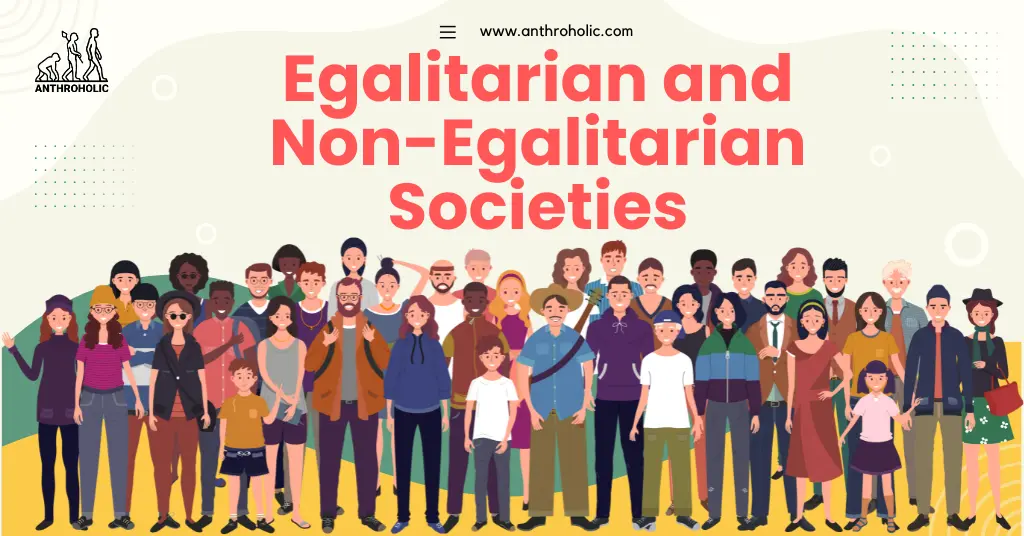AI Answer Evaluation Platform Live Now. Try Free Answer Evaluation Now
Egalitarian and Non-Egalitarian Societies
In anthropology, societies are often categorized based on their socio-economic structures, power dynamics, and political ideologies. Two fundamental categories in this regard are egalitarian and non-egalitarian societies [1]. Egalitarian societies emphasize equality among individuals in terms of access to resources, decision-making power, and social standing. On the other hand, non-egalitarian societies display significant disparities in these areas, often leading to a hierarchical social structure.

Egalitarian Societies
Characteristics
Egalitarian societies are characterized by a fundamental equality among members. These societies tend to exhibit:
- Shared resources: Resources are distributed evenly, and there is a low degree of wealth disparity.
- Equal decision-making power: All members have an equal say in matters that affect the community.
- Lack of rigid social hierarchies: There are no rigid social classes, and every individual has the same social standing.
- Small-scale communities: These societies often exist in small communities like bands of hunter-gatherers.
Table 1 illustrates some notable examples of egalitarian societies throughout history.
| Society | Region | Era |
|---|---|---|
| Hadza People | Tanzania | Present |
| San People | Southern Africa | Present |
| Aka Pygmies | Central Africa | Present |
| !Kung San | Kalahari Desert | Present |
Impact on Culture
In egalitarian societies, cooperation and reciprocity are heavily emphasized, often leading to unique cultural manifestations. The absence of material wealth as a status symbol can lead to an emphasis on other forms of status, such as knowledge, wisdom, or skill [2].
Non-Egalitarian Societies
Characteristics
Non-egalitarian societies are marked by unequal distribution of resources, power, and social standing. Their key characteristics include:
- Wealth and resource disparity: Wealth and resources are not evenly distributed, with a small group possessing a significant portion.
- Hierarchical decision-making: A few individuals or groups hold decision-making power.
- Defined social hierarchies: There are clear social classes, often determined by birth, wealth, or occupation.
Table 2 showcases examples of non-egalitarian societies.
| Society | Region | Era |
|---|---|---|
| Feudal Europe | Europe | Middle Ages |
| Caste System in India | India | Ancient to Modern |
| Aztec Empire | Mesoamerica | 14th-16th Century |
Impact on Culture
In non-egalitarian societies, culture often revolves around power structures and status symbols. There is usually a distinct culture of the elites, which can be distinct from that of the lower classes. Wealth, power, and social status often become significant cultural motifs [3].
Comparative Analysis: Egalitarian Vs Non-Egalitarian Societies
Wealth and Resource Distribution
In egalitarian societies, wealth and resources are shared, often leading to a stronger sense of community but potentially limiting individual ambition or competition. In non-egalitarian societies, the uneven distribution can drive economic growth and competition but can also result in poverty and social unrest.
Decision-making
Egalitarian societies are characterized by consensus decision-making, which ensures equal representation but can be time-consuming. Non-egalitarian societies often have faster decision-making processes but may ignore the needs of some sections of the society.
Social Hierarchies
Egalitarian societies typically lack defined social hierarchies, fostering equality but potentially limiting specialization. Non-egalitarian societies have well-defined hierarchies that can enable efficient division of labor but can also foster social inequality and discrimination.
Conclusion
The structures of egalitarian and non-egalitarian societies highlight different aspects of human social organization. While egalitarian societies reflect values of equality and shared responsibility, non-egalitarian societies underscore the human inclination towards structure, hierarchy, and individual achievement. Understanding these societies offers valuable insights into the diverse ways humans have structured their communities throughout history.
References
[1] Boehm, C. (1993). Egalitarian Behavior and Reverse Dominance Hierarchy. Current Anthropology, 34(3), 227-254.
[2] Woodburn, J. (1982). Egalitarian Societies. Man, 17(3), 431-451.
[3] Lenski, G. (1966). Power and Privilege: A Theory of Social Stratification. UNC Press Books.




